1997 MERCEDES-BENZ ML350 sensor
[x] Cancel search: sensorPage 2194 of 4133

Ignition coil
Fig. 24: Identifying Double Open
-End Wrench (110 589 01 01 00)
REMOVE/INSTALL CRANKSHAFT POSITION SENSOR - AR15.12-P-2133A
ENGINE 112.910 in MODEL 202.026 /086
ENGINE 112.920 in MODEL 202.029 /089
ENGINE 112.921 in MODEL 210.063 /081 /263 /281
ENGINE 112.922 in MODEL 220.063
ENGINE 112.923 in MODEL 129.059
ENGINE 112.940 in MODEL 208.365 /465
to T1/6) or 1 to 8 (T1/1
to T1/8)
8Remove ignition coil of
cylinder 1 to 6 (T1/1 to
T1/6)or 1 to 8(T1/1 to
T1/8)
9Install in the reverse
order
10.1Activate Service mode in
Tele-Aid emergency call
system Only on model 463.270 with
code: Tele-Aid car phone
emergency call system ET2.AR82.95-P-0005-
03GR
Notes on TELE AID
emergency call systemModel
463.243/244/245/247/248/250/
254/270/309/322/323/332/333
TELE AID car telephone
emergency call system ET2AH82.95-P-0001-
01GA
NumberDesignationEngines 112,113
BA15.10-P-1001-04ABolt for ignition coil on
cylinder head coverNm8
2001 Mercedes-Benz ML320
1998-2005 ENGINE Electrical System - Engine - 163 Chassis
me
Saturday, October 02, 2010 3:18:54 PMPage 40 © 2006 Mitchell Repair Information Company, LLC.
Page 2197 of 4133
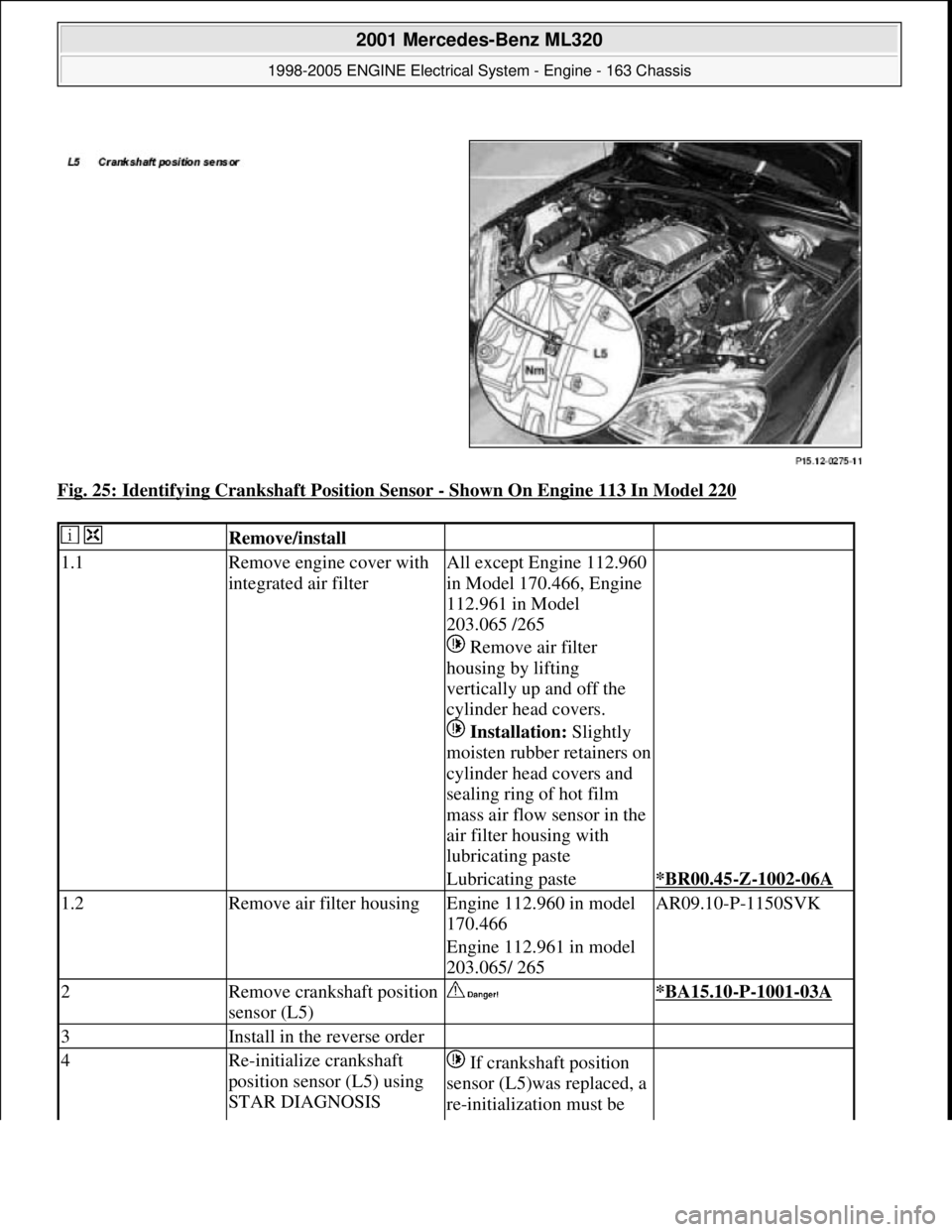
Fig. 25: Identifying Crankshaft Position Sensor - Shown On Engine 113 In Model 220
Remove/install
1.1Remove engine cover with
integrated air filterAll except Engine 112.960
in Model 170.466, Engine
112.961 in Model
203.065 /265
Remove air filter
housing by lifting
vertically up and off the
cylinder head covers.
Installation: Slightly
moisten rubber retainers on
cylinder head covers and
sealing ring of hot film
mass air flow sensor in the
air filter housing with
lubricating paste
Lubricating paste*BR00.45-Z-1002-06A
1.2Remove air filter housingEngine 112.960 in model
170.466AR09.10-P-1150SVK
Engine 112.961 in model
203.065/ 265
2Remove crankshaft position
sensor (L5) *BA15.10-P-1001-03A
3Install in the reverse order
4Re-initialize crankshaft
position sensor (L5) using
STAR DIAGNOSIS If crankshaft position
sensor (L5)was replaced, a
re-initialization must be
2001 Mercedes-Benz ML320
1998-2005 ENGINE Electrical System - Engine - 163 Chassis
me
Saturday, October 02, 2010 3:18:54 PMPage 43 © 2006 Mitchell Repair Information Company, LLC.
Page 2198 of 4133
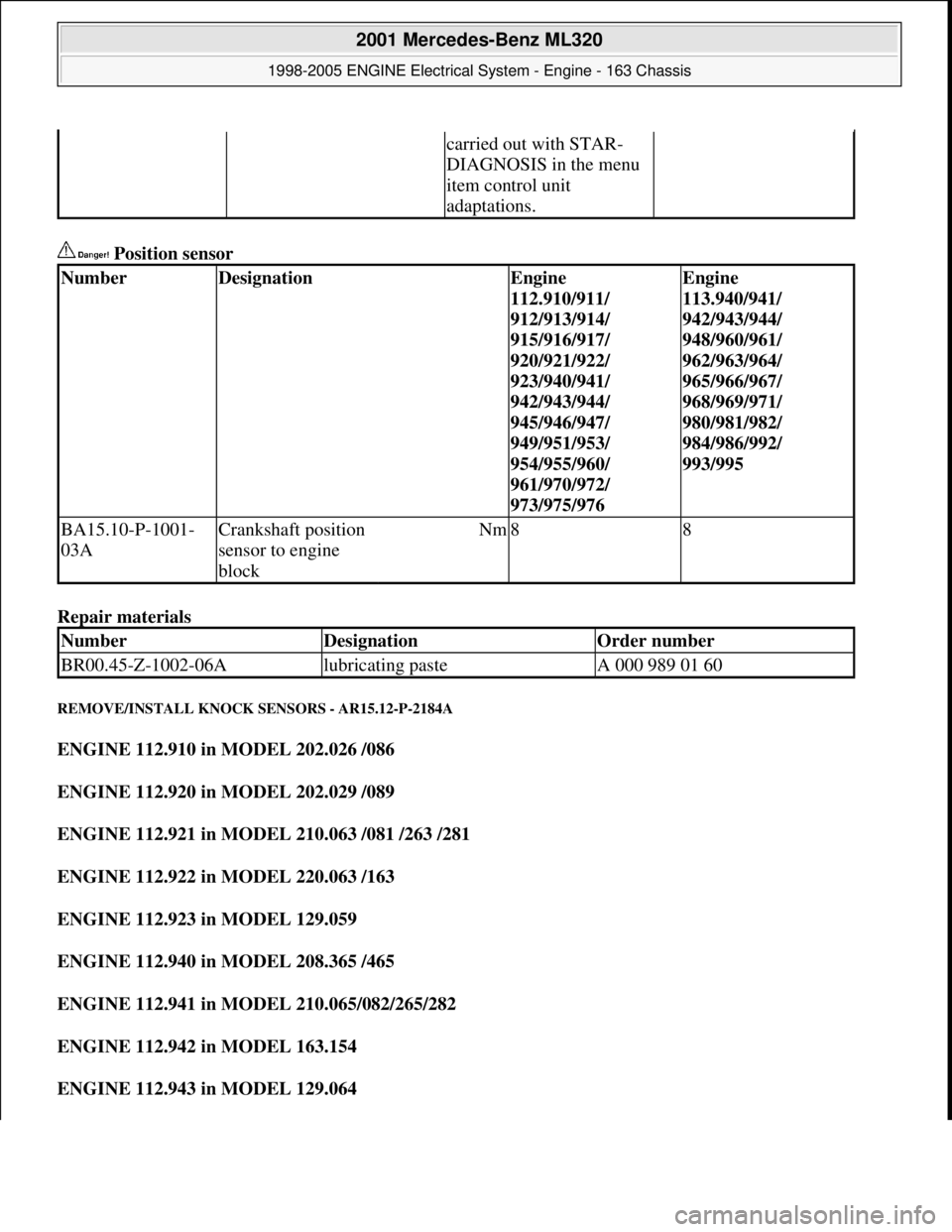
Position sensor
Repair materials
REMOVE/INSTALL KNOCK SENSORS - AR15.12-P-2184A
ENGINE 112.910 in MODEL 202.026 /086
ENGINE 112.920 in MODEL 202.029 /089
ENGINE 112.921 in MODEL 210.063 /081 /263 /281
ENGINE 112.922 in MODEL 220.063 /163
ENGINE 112.923 in MODEL 129.059
ENGINE 112.940 in MODEL 208.365 /465
ENGINE 112.941 in MODEL 210.065/082/265/282
ENGINE 112.942 in MODEL 163.154
ENGINE 112.943 in MODEL 129.064
carried out with STAR-
DIAGNOSIS in the menu
item control unit
adaptations.
NumberDesignationEngine
112.910/911/
912/913/914/
915/916/917/
920/921/922/
923/940/941/
942/943/944/
945/946/947/
949/951/953/
954/955/960/
961/970/972/
973/975/976Engine
113.940/941/
942/943/944/
948/960/961/
962/963/964/
965/966/967/
968/969/971/
980/981/982/
984/986/992/
993/995
BA15.10-P-1001-
03ACrankshaft position
sensor to engine
blockNm88
NumberDesignationOrder number
BR00.45-Z-1002-06Alubricating pasteA 000 989 01 60
2001 Mercedes-Benz ML320
1998-2005 ENGINE Electrical System - Engine - 163 Chassis
me
Saturday, October 02, 2010 3:18:54 PMPage 44 © 2006 Mitchell Repair Information Company, LLC.
Page 2201 of 4133
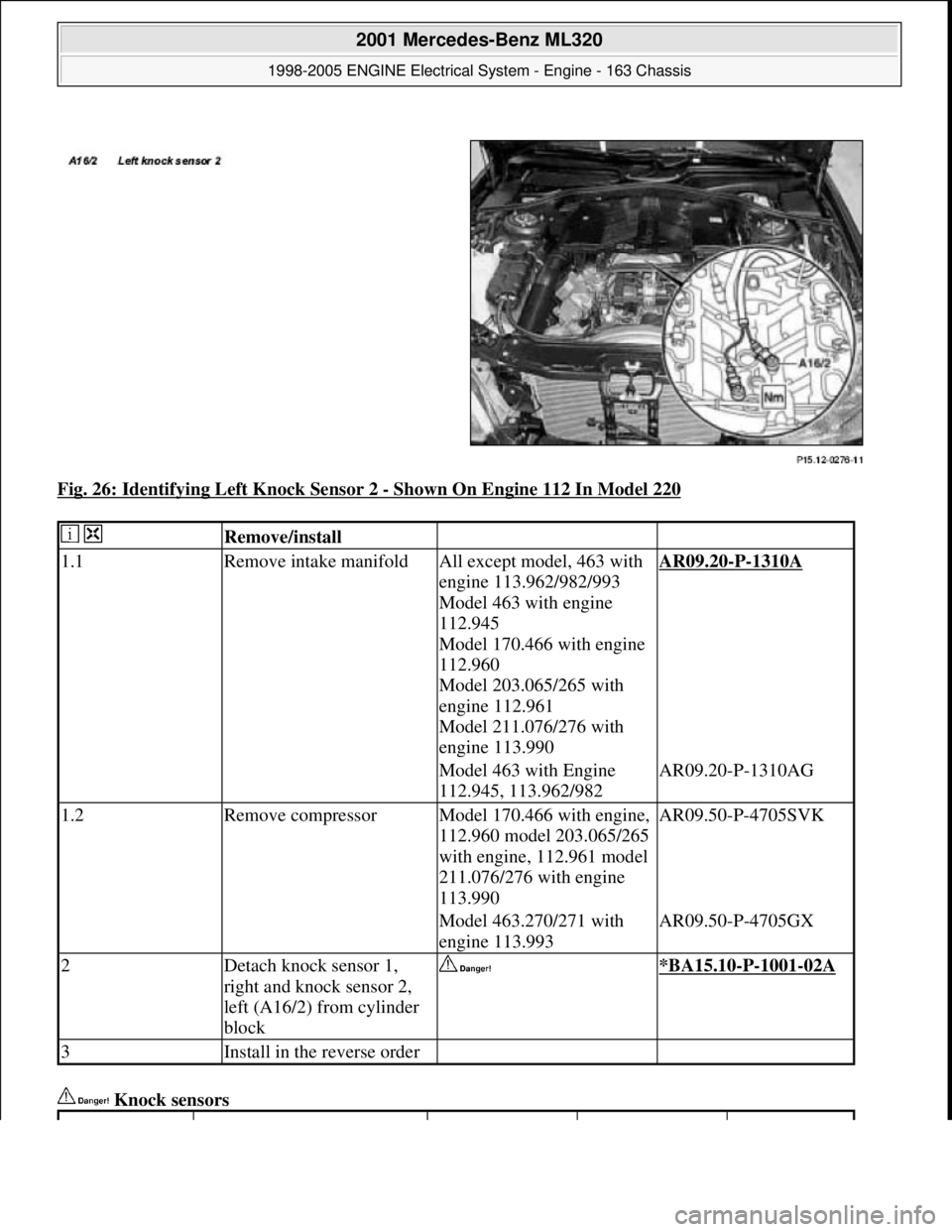
Fig. 26: Identifying Left Knock Sensor 2 - Shown On Engine 112 In Model 220
Knock sensors
Remove/install
1.1Remove intake manifoldAll except model, 463 with
engine 113.962/982/993
Model 463 with engine
112.945
Model 170.466 with engine
112.960
Model 203.065/265 with
engine 112.961
Model 211.076/276 with
engine 113.990AR09.20-P-1310A
Model 463 with Engine
112.945, 113.962/982AR09.20-P-1310AG
1.2Remove compressorModel 170.466 with engine,
112.960 model 203.065/265
with engine, 112.961 model
211.076/276 with engine
113.990AR09.50-P-4705SVK
Model 463.270/271 with
engine 113.993AR09.50-P-4705GX
2Detach knock sensor 1,
right and knock sensor 2,
left (A16/2) from cylinder
block *BA15.10-P-1001-02A
3Install in the reverse order
2001 Mercedes-Benz ML320
1998-2005 ENGINE Electrical System - Engine - 163 Chassis
me
Saturday, October 02, 2010 3:18:54 PMPage 47 © 2006 Mitchell Repair Information Company, LLC.
Page 2202 of 4133
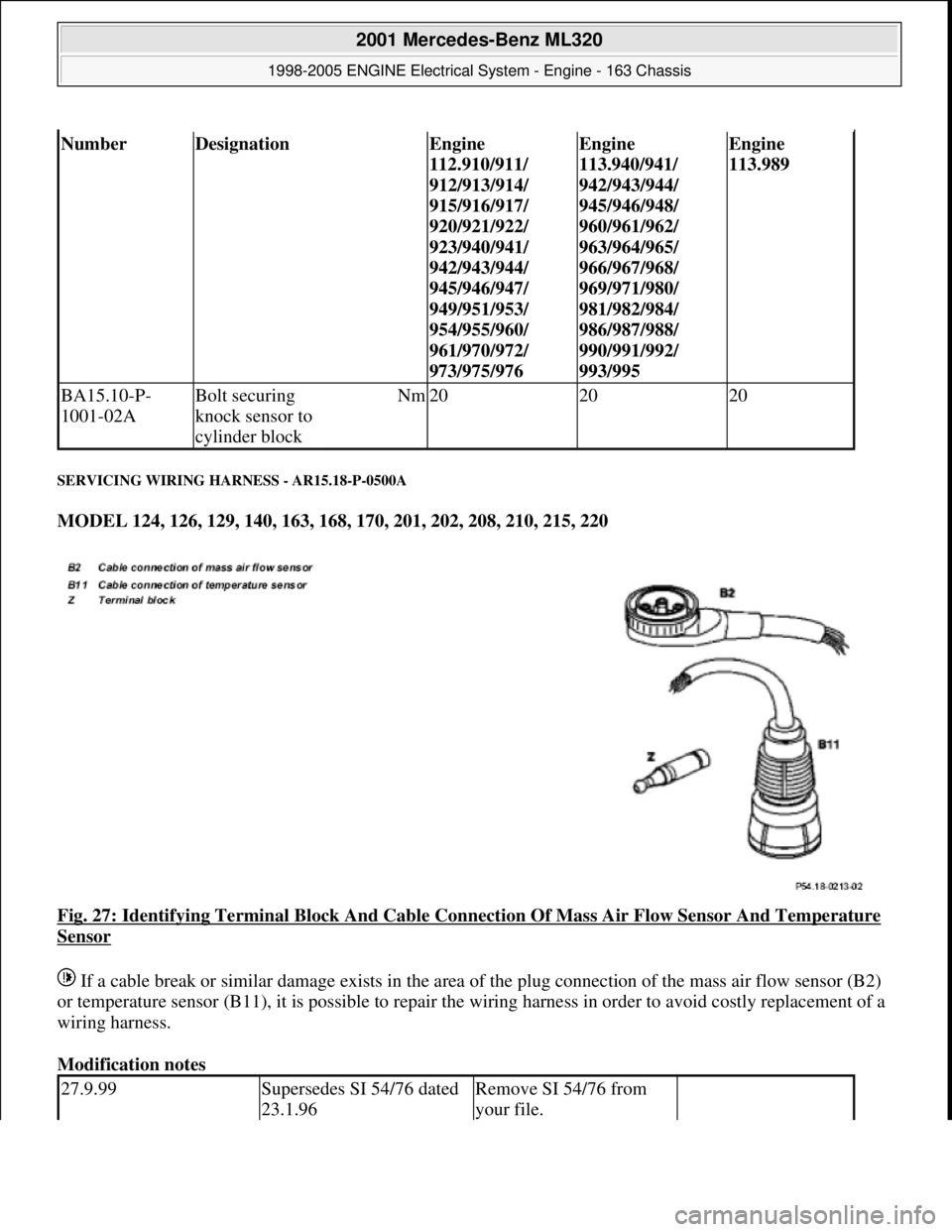
SERVICING WIRING HARNESS - AR15.18-P-0500A
MODEL 124, 126, 129, 140, 163, 168, 170, 201, 202, 208, 210, 215, 220
Fig. 27: Identifying Terminal Block And Cable Connection Of Mass Air Flow Sensor And Temperature
Sensor
If a cable break or similar damage exists in the area of the plug connection of the mass air flow sensor (B2)
or temperature sensor (B11), it is possible to repair the wiring harness in order to avoid costly replacement of a
wiring harness.
Modification notes
NumberDesignationEngine
112.910/911/
912/913/914/
915/916/917/
920/921/922/
923/940/941/
942/943/944/
945/946/947/
949/951/953/
954/955/960/
961/970/972/
973/975/976Engine
113.940/941/
942/943/944/
945/946/948/
960/961/962/
963/964/965/
966/967/968/
969/971/980/
981/982/984/
986/987/988/
990/991/992/
993/995Engine
113.989
BA15.10-P-
1001-02ABolt securing
knock sensor to
cylinder blockNm202020
27.9.99Supersedes SI 54/76 dated
23.1.96Remove SI 54/76 from
your file.
2001 Mercedes-Benz ML320
1998-2005 ENGINE Electrical System - Engine - 163 Chassis
me
Saturday, October 02, 2010 3:18:54 PMPage 48 © 2006 Mitchell Repair Information Company, LLC.
Page 2203 of 4133

Parts ordering notes
REMOVE AND INSTALLING THE STARTER - AR15.30-P-7100GH
ENGINE 112.942 in MODEL 163.154
Removing and installing
1Remove air cleaner, install. Only on engine 119
2Expose wiring harness to
mass air flow sensor or
temperature sensor. Ignition switched
off
3Unplug socket from mass
air flow sensor or
temperature sensor.
4Plug in repair socket
together with cables at
mass air flow sensor or
temperature sensor and
insert into cable duct.
5Repair wiring harness
using end soldering sleeves
(Z). Turn together cable of
engine wiring harness and
cable repair socket of the
same color and insert into
end soldered sleeves (Z).
Use end soldered
sleeves (Z) only in cross
section area Ø 0.7 - Ø 4.0
mm
2
AR54.18-P-0100-02A
6Insert cables into the cable
duct.
7Connect HHT, read faults
and erase see Diagnosis Manual
Engine Volume 2 Index 0:
Connecting and using test
equipment
8Install in the reverse order
Part no.DesignationQuantity
140 540 00 36Repair kit socket (B2)1
1) Consisting of repair socket (B2)
and 5 cable connectorsacc. to condition
140 540 00 81Repair socket (B2)acc. to condition
202 540 01 81Repair socket (B11) 3-pinacc. to condition
126 540 30 81Repair socket (B11) 4-pinacc. to condition
001 546 99 41Cable connectoracc. to condition
006 989 84 85Fabric tapeacc. to condition
2001 Mercedes-Benz ML320
1998-2005 ENGINE Electrical System - Engine - 163 Chassis
me
Saturday, October 02, 2010 3:18:54 PMPage 49 © 2006 Mitchell Repair Information Company, LLC.
Page 2236 of 4133

GF00.20-P-2009A
Engine oil monitor function
24.10.96
MODEL
129 with ENGINE 112, 113
MODEL
163 with ENGINE 112, 113, 612
MODEL
168 with ENGINE 166, 668
MODEL
202 with ENGINE 112, 611
MODEL
208 up to 31.7.99 with ENGINE 112, 113
MODEL
210 up to 30.6.99 with ENGINE 112, 113, 611
General
The oil level is constantly monitored by the oil sensor, and the
appropriate data transmitted to the processor by the ASSYST.
Oil replenishments are detected automatically and result in a bonus,
which extends the service interval accordingly.
An excess oil level or insufficient oil level appears in the display
together with the oil can symbol.
Display of low oil level at maximum:
D
at driver request
Display of warnings: D
automatically, at the earliest 60 s after engine start and oil
temperature greater than 60°C:
D
if oil level too high: the oil can symbol appears together
with the readout "OIL LEVEL ABOVE MAX". In addition, a
brief warning signal sounds. (On models not fitted with
multifunction displaly, "HI" appears flashing.)
D
if oil level too low: the oil can symbol appears together with
the readout "OIL LEVEL BELOW MIN". In addition, a brief
warning signal sounds. (On models not fitted with multifunction
display, the oil level warning lamp (A1e12) comes on and the
readout "-2L" appears flashing.)
-----------------------------------------------------------------------------------------
D
if oil at minimum: the oil can symbol appears together with
the readout "OIL LEVEL MINIMUM". In addition, a brief
warning signal sounds. (On models not fitted with multifunction
display, the oil level warning lamp (A1e12) comes on.)
D
automatically 13 s after ignition ON:
D
if
no oil
is in engine: the oil can symbol appears together
with the readout "OIL LEVEL BELOW MIN". In addition, a
warning signal sounds. (On models not fitted with multifunction
display, the oil level warning lamp (A1e12) comes on and the
readout "-2L"appears flashing. In addition a brief warning
signal sounds.)
The missing oil quantity displayed no longer changes during the
display. In other words, any change in oil level cannot be observed
directly at the display. The new oil level is only displayed once the
conditions described below exist.
Display of oil quantity at driver request
The text "DISPLAY OIL LEVEL?" appears 10 s after the start switch
has been turned into position "2" (on models not fitted with
multifunction display, the oil can and the clock symbol are displayed).
If the reset button of the trip counter is pressed twice within one sec.
during this readout, for example, "add 1.0L oil" (or "-1.0L")
-----------------------------------------------------------------------------------------
appears in the display if oil level too low. The readout appears only
after the elapse of a waiting time after engine OFF. The waiting time
depends on the engine oil temperature.
It is
D
up to 20°C
30 minutes
D
from 60°C
1 minute
D
The waiting time is between these two limits at other engine oil
temperatures.
Possible readouts are (text in parenthesis relates to models not fitted
with multifunction display.):
D
"OIL LEVEL OKAY" ("o.k."),
D
1.0L, 1.5L, 2L,
D
"Overfilling" ("HI"),
D
"OBSERVE WAITING TIME" (clock symbol flashing and oil can
symbol),
D
"DISPLAY OIL LEVEL" (clock and oil can symbols.)
If there is a fault at the oil sensor (oil level/temperature/quality, B40)
the oil can symbol and the text "OIL LEVEL SENSOR FAULTY"
appears only 30 s after the fault has occurred.
(On models not fitted with multifunction display, the oil level warning
lamp (A1e12) comes on accordingly.)
For diagnosis, read also the injection system control module (N3)
with the HHT. (The instrument cluster (A1) receives the sensor data
through the CAN from the injection system control module (N3)).
-----------------------------------------------------------------------------------------
Oil change
The ASSYST has to be reset each time the oil is changed. Resetting
ASSYST also resets the remaining time and the remaining distance.
Resetting can be performed at the instrument cluster or using the
HHT.
The following data are stored when the system is reset:
D
current kilometer reading rounded off to 100,
D
total oil replenishments in the last interval,
D
remaining distance,
D
remaining time,
D
product of the quality factors,
D
the data of the last 5 resettings in 5 data sets
These data can only be read with the HHT!
If the specified quantity of oil is not replenished when the oil is
changed, the (internal) start distance is reduced.
Detecting oil replenishments
D
With the
HHT
it is possible to retrieve the last 10 oil
replenishments and the corresponding kilometer readings of
the current interval.
D
In the normal case, detection of an oil replenishment is
displayed by the remaining distance in the instrument cluster
being extended
-----------------------------------------------------------------------------------------
Copyright DaimlerChrysler AG 05.06.2006 CD-Ausgabe G/10/04 . This WIS print-out will not be recorde
d by Modification services.
Page 1
Page 2237 of 4133
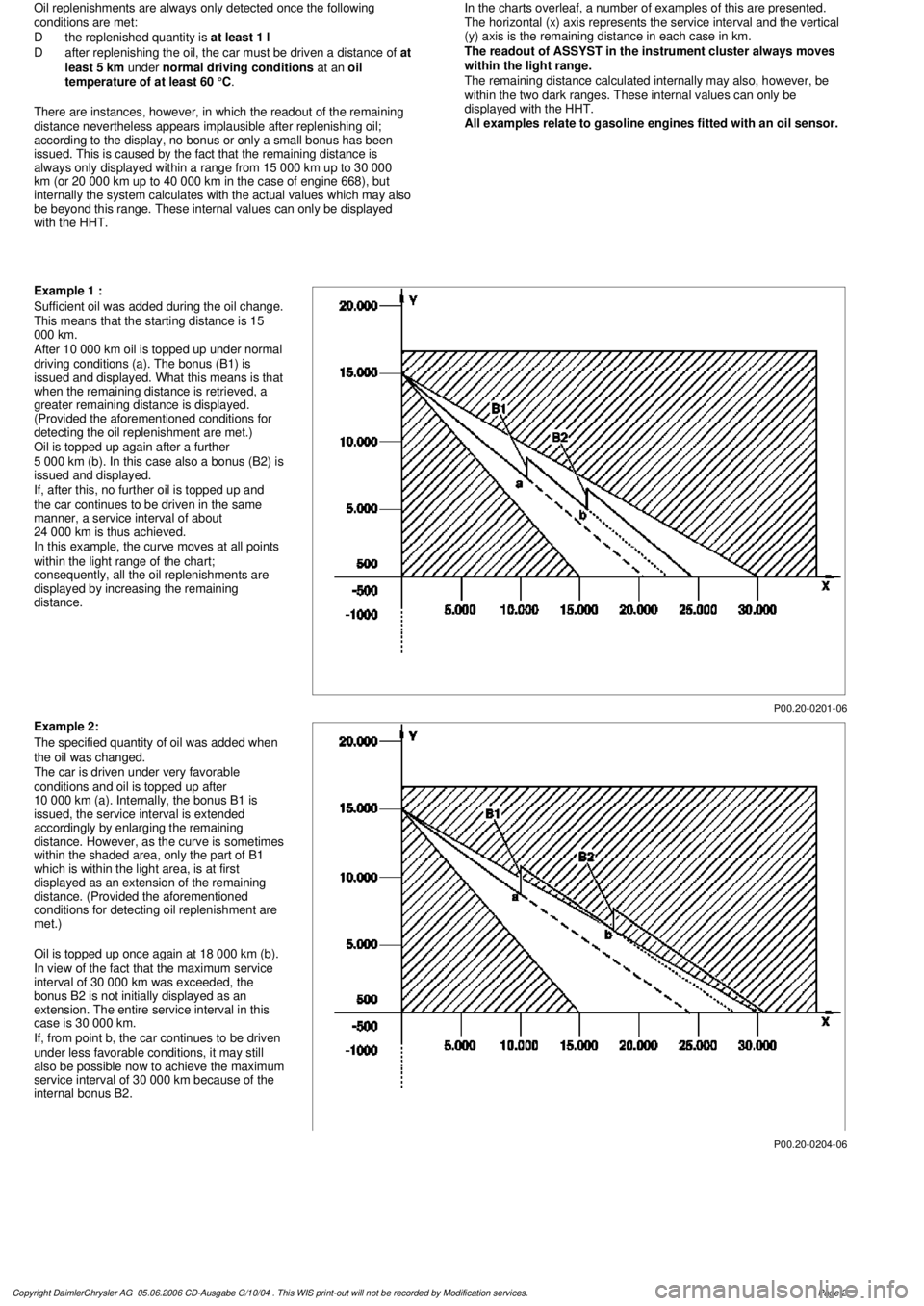
Oil replenishments are always only detected once the following
conditions are met:
D
the replenished quantity is
at least 1 l
D
after replenishing the oil, the car must be driven a distance of
at
least 5 km
under
normal driving conditions
at an
oil
temperature of at least 60 °C
.
There are instances, however, in which the readout of the remaining
distance nevertheless appears implausible after replenishing oil;
according to the display, no bonus or only a small bonus has been
issued. This is caused by the fact that the remaining distance is
always only displayed within a range from 15 000 km up to 30 000
km (or 20 000 km up to 40 000 km in the case of engine 668), but
internally the system calculates with the actual values which may also
be beyond this range. These internal values can only be displayed
with the HHT.
In the charts overleaf, a number of examples of this are presented.
The horizontal (x) axis represents the service interval and the vertical
(y) axis is the remaining distance in each case in km.
The readout of ASSYST in the instrument cluster always moves
within the light range.
The remaining distance calculated internally may also, however, be
within the two dark ranges. These internal values can only be
displayed with the HHT.
All examples relate to gasoline engines fitted with an oil sensor.
P00.20-0201-06
Example 1 :
Sufficient oil was added during the oil change.
This means that the starting distance is 15
000 km.
After 10 000 km oil is topped up under normal
driving conditions (a). The bonus (B1) is
issued and displayed. What this means is that
when the remaining distance is retrieved, a
greater remaining distance is displayed.
(Provided the aforementioned conditions for
detecting the oil replenishment are met.)
Oil is topped up again after a further
5 000 km (b). In this case also a bonus (B2) is
issued and displayed.
If, after this, no further oil is topped up and
the car continues to be driven in the same
manner, a service interval of about
24 000 km is thus achieved.
In this example, the curve moves at all points
within the light range of the chart;
consequently, all the oil replenishments are
displayed by increasing the remaining
distance.
P00.20-0204-06
Example 2:
The specified quantity of oil was added when
the oil was changed.
The car is driven under very favorable
conditions and oil is topped up after
10 000 km (a). Internally, the bonus B1 is
issued, the service interval is extended
accordingly by enlarging the remaining
distance. However, as the curve is sometimes
within the shaded area, only the part of B1
which is within the light area, is at first
displayed as an extension of the remaining
distance. (Provided the aforementioned
conditions for detecting oil replenishment are
met.)
Oil is topped up once again at 18 000 km (b).
In view of the fact that the maximum service
interval of 30 000 km was exceeded, the
bonus B2 is not initially displayed as an
extension. The entire service interval in this
case is 30 000 km.
If, from point b, the car continues to be driven
under less favorable conditions, it may still
also be possible now to achieve the maximum
service interval of 30 000 km because of the
internal bonus B2.
Copyright DaimlerChrysler AG 05.06.2006 CD-Ausgabe G/10/04 . This WIS print-out will not be recorde
d by Modification services.
Page 2